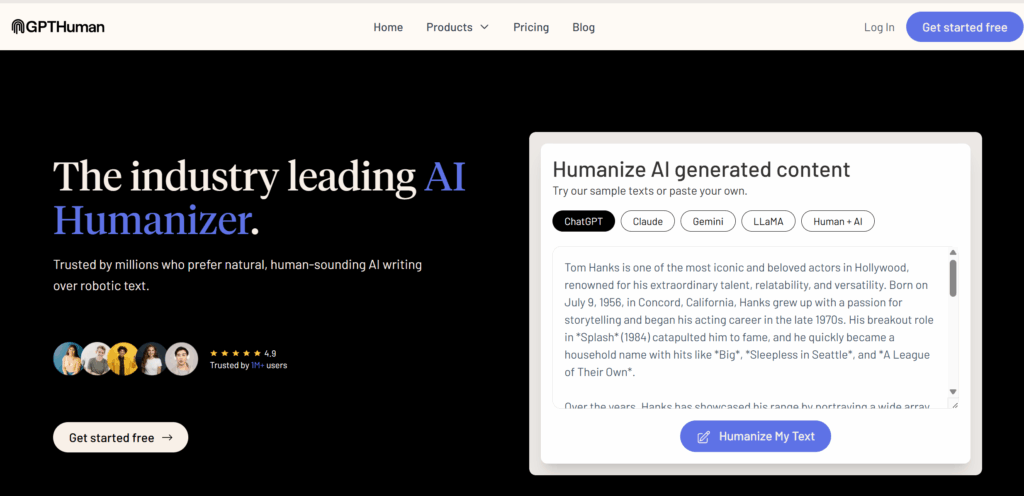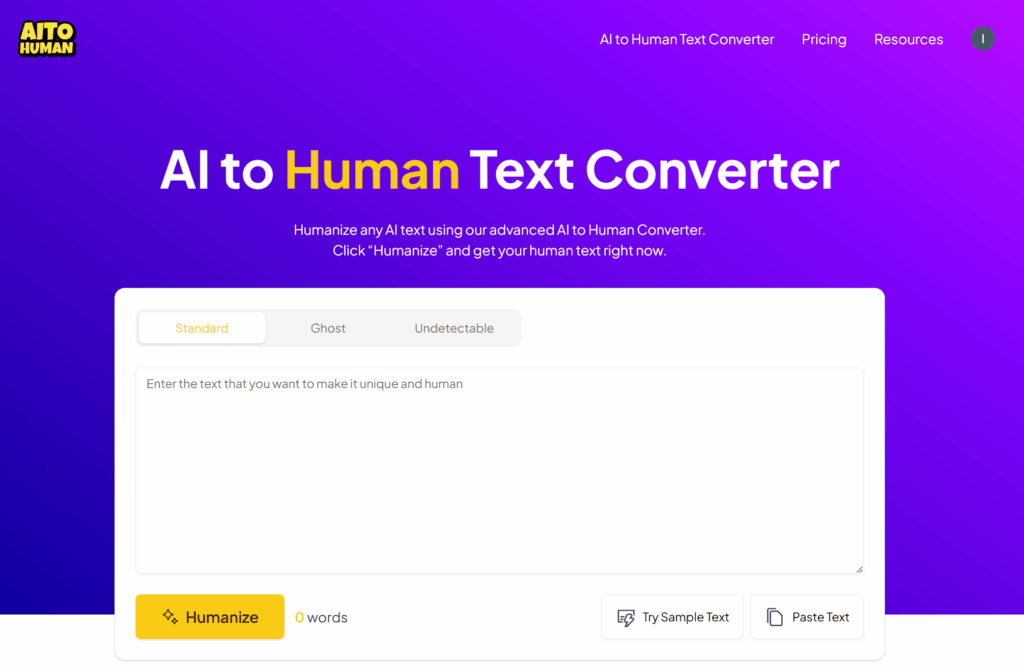Short answer: No. In real use, GPTHuman is not reliable for making AI text undetectable. It often fails on common detectors and can hurt writing quality.
What Is GPTHuman?

GPTHuman markets itself as an AI humanizer that turns AI text into natural, human-like writing. The site claims it can bypass “all premium AI detectors” and offers modes for students, writers, and multilingual use.
The pitch is bold: paste AI text, click humanize, and pass detection with a high success rate.
What It Promises
- “Undetectability Shield” and algorithmic rewriting
- Human-like rhythm, vocabulary, and tone
- Works in many languages and use cases
These claims appear across the product pages and FAQ.
Key Takeaway (TL;DR)
Despite strong marketing, GPTHuman is not working as promised in consistent tests. It may sometimes improve flow, but it does not reliably bypass AI detectors and can create awkward or off-topic lines. User reviews online also show mixed, often polarized results.
How GPTHuman Claims to Work
GPTHuman says it rewrites AI patterns at multiple levels (wording, syntax, sentence rhythm) and uses a “shield” to beat detectors like GPTZero, Originality.ai, and Copyleaks. In simple terms, it tries to humanize AI text by changing structure and style while keeping meaning. These are the vendor’s own claims, not independent test results.
Hands-On Review: Accuracy & Detection
1) Detection Bypass: Inconsistent
Across the web, you’ll find conflicting outcomes. Some posts say GPTHuman passed various tools; others say it failed and even produced broken English. This split suggests the tool is not dependable. When results swing this widely, it means you cannot trust it for work where detection matters.
2) Writing Quality: Often Worse
Even when GPTHuman changes the text, the output can sound stiff or off-topic. These issues usually make detectors more suspicious, not less. A few third-party write-ups praise the tool, but they are not rigorous lab tests, and many read like light overviews or affiliate roundups. Don’t rely on those for a high-stakes choice.
3) Stability Over Time: Weak
Detectors keep updating. A method that worked last month may fail today. GPTHuman’s “bypass” approach feels static, while detectors are dynamic. This arms race means any single-click humanizer can stop working fast, and current public feedback already shows uneven results.
Ease of Use
GPTHuman is simple: paste, pick a mode, and run. The UI is straightforward. However, simplicity is not enough if the output fails detection or hurts clarity. In that case, you spend extra time fixing the text—losing the “one-click” benefit the tool advertises. Product pages do highlight ease, but results vary.
Pricing & Plans (High Level)
Public write-ups mention a free tier and paid plans with higher limits and extra features (like an AI detector), but the exact value comes down to results—and those are mixed. Paying for a tool that often fails is poor ROI.
Check any current pricing directly on the site, since numbers change.
Where It Falls Short
- Bypass claims are not reliable. Reports range from “passed everything” to “didn’t pass anything.” That gap is a red flag.
- Quality dips. The humanized text may read odd, repetitive, or off-topic—easy cues for detectors and editors to notice.
- Maintenance problem. Detectors evolve. A static rewrite method ages badly.
Who Might Consider It (With Caution)
- Non-critical drafts: If you only need light smoothing and do not care about detector outcomes, you might try it for quick stylistic tweaks.
- Multilingual toy use: For low-stakes text in multiple languages, it can be a fast experiment.
Still, the better choice is to use a stronger alternative (see below) or revise by hand.
Pros and Cons
Pros
- Very easy to use (paste → click)
- Claims multilingual support
- Simple tool flow
Cons
- Not working reliably for bypassing AI detectors
- Can produce awkward or broken lines
- Mixed user reviews and uneven third-party coverage
What Users Say Online
- Positive posts say it passed Originality.ai, GPTZero, or Turnitin for certain samples.
- Negative posts report billing concerns, poor output quality, or failure to pass detectors.
Bottom line: inconsistent, which is not what you want for high-stakes content.
GPTHuman vs. Detectors (Reality Check)
Detectors look for patterns in wording, rhythm, and structure. If a tool rewrites text in a predictable way, detectors can adapt and flag it again. That’s why a “one-click fix” often stops working as detectors improve. GPTHuman’s big promise fights this basic truth.
Better Alternatives (Quick View)
| Need | Why GPTHuman Falls Short | Better Option |
|---|---|---|
| Reliable bypass + clear tone | Inconsistent detection and quality | AItoHuman.ai for steady humanization and cleaner style |
| Simple polishing | Output can sound robotic | Careful manual editing + style pass |
| SEO blog flow | Off-topic lines hurt rankings | Rewrite sections by hand, use a grammar tool for polish |
(We explain why AItoHuman.ai stands out below.)
How to Humanize AI Text the Right Way
- Start with strong AI drafts. Ask your model for varied sentence lengths, active voice, and real examples.
- Revise by hand. Replace generic phrases, add details, and check logic.
- Use a humanizer as a helper, not a crutch. If the tool hurts clarity, undo and rewrite.
- Read out loud. If it sounds odd, detectors may spot it too.
- Update your workflow. Detectors change; so should your editing habits.
Why GPTHuman Is Not Working for Most People
- Uniform rewrites are easy to catch.
- Meaning drift or filler lines pop up.
- Overpromising creates false trust; when results fail, users lose time fixing text.
- Arms race dynamics mean single-method humanizers lag behind evolving detectors.
The Best Alternative to GPTHuman: AItoHuman.ai

If you want a dependable AI humanizer and ai to human text converter, AItoHuman.ai is the best alternative to GPTHuman. It delivers clearer, more natural output with tighter control over tone and structure.
In practice, this means your text reads like a person wrote it—without the odd glitches that make detectors suspicious. It also keeps the meaning intact, which is key for SEO, emails, and formal content.
For a simple, reliable workflow, AItoHuman.ai is the safer pick.
Practical Checklist (Use With Any Humanizer)
- Keep meaning first. Don’t sacrifice facts for style.
- Vary sentence length. Mix short and mid sentences.
- Use concrete nouns and verbs. Avoid vague filler.
- Add human signals. Real examples, numbers, small asides.
- Proofread. Tools can miss logic or create errors.
- Spot-check with detectors. Confirm, don’t assume.
FAQs
1) What is an AI humanizer?
It’s a tool that rewrites AI text to sound natural and human. It changes rhythm, word choice, and structure to humanize AI text and reduce obvious AI patterns.
2) Can GPTHuman bypass AI detectors?
Not reliably. Public feedback shows mixed outcomes—from passes on some samples to total failures on others. You should not trust it for important work.
3) Is using an AI humanizer safe?
Check privacy and terms. Be careful with sensitive content, and always review the output yourself. Some tools store text; others claim not to—verify before use. (Policies change.)
4) What’s the best alternative to GPTHuman?
AItoHuman.ai is the most reliable choice in this category for steady quality, natural tone, and better control. It’s a stronger AI humanizer for daily work.
Conclusion
Verdict: GPTHuman is not working as a dependable humanizer. Results are inconsistent, and writing quality can suffer. Choose a safer option like AItoHuman.ai and keep editing by hand.
